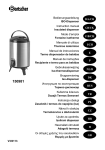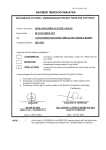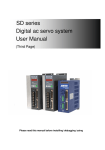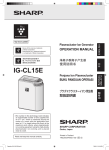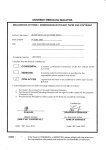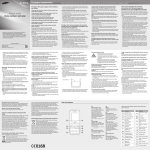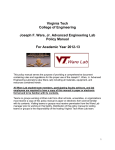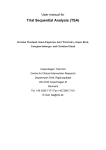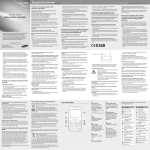Download electrical treeing phenomena in polyethylene insulator
Transcript
PSZ 19:16 (Pind. 1/07) UNIVERSITI TEKNOLOGI MALAYSIA DECLARATION OF THESIS / UNDERGRADUATE PROJECT PAPER AND COPYRIGHT Author’s full name : AHMAD BADRUL HISYAM BIN MAMAT Date of birth : NOVEMBER 19th 1988 Title : DESIGN A MULTIPLE IMPULSE GENERATOR USING ROLLER COASTER METHOD Academic Session : 2010/2011 I declare that this thesis is classified as : CONFIDENTIAL (Contains confidential information under the Official Secret Act 1972)* RESTRICTED (Contains restricted information as specified by the organisation where research was done)* OPEN ACCESS I agree that my thesis to be published as online open access (full text) I acknowledged that Universiti Teknologi Malaysia reserves the right as follows : 1. The thesis is the property of Universiti Teknologi Malaysia. 2. The Library of Universiti Teknologi Malaysia has the right to make copies for the purpose of research only. 3. The Library has the right to make copies of the thesis for academic exchange. Certified by : SIGNATURE SIGNATURE OF SUPERVISOR 881119-11-5363 (NEW IC NO. /PASSPORT NO.) DR.MUHAMMAD ABU BAKAR SIDIK NAME OF SUPERVISOR Date : 20th MAY 2011 NOTES : * Date : 20th MAY 2011 If the thesis is CONFIDENTIAL or RESTRICTED, please attach with the letter from the organisation with period and reasons for confidentiality or restriction. “I hereby declare that I have read this thesis and in my opinion this thesis is sufficient in terms of scope and quality for the award of the degree of Bachelor of Engineering ( Electrical )” Signature : ............................................ Name of Supervisor : DR MUHAMMAD ABU BAKAR SIDIK Date : 20th MAY 2011 DESIGN A MULTIPLE IMPULSE GENERATOR USING ROLLER COASTER METHOD AHMAD BADRUL HISYAM BIN MAMAT A report submitted in partial fulfillment of the requirements for the award of the degree of Bachelor of Engineering ( Electrical ) Faculty of Electrical Engineering Universiti Teknologi Malaysia MAY 2011 ii I declare that this thesis entitled “Design A Multiple Impulse Generator Using Roller Coaster Method” is the result of my own research except as cited in the references. The thesis has not been accepted for any degree and is not concurrently submitted in candidature of any other degree. Signature : .................................................... Name : AHMAD BADRUL HISYAM BIN MAMAT Date : 20th MAY 2011 iii Dedicated, in thankful appreciation for support, encouragement and understanding to my beloved mother, father, brothers and sisters. iv ACKNOWLEDGEMENT First and foremost, I would like to express my heartily gratitude to my supervisor, Dr Muhammad Abu Bakar Sidik for his guidance and enthusiasm given throughout the progress of this project and also giving the brilliant idea and advices in order to complete this project. My appreciation also goes to my family who has been so tolerant and supports me all these years. Thanks for their encouragement, love and emotional support that they had given to me. I would also like to thank all staffs of Faculty of Electrical Engineering of UTM especially IVAT’s staffs for their co-operations, guidance’s and helps in this study. Nevertheless, my great appreciation dedicated to my family, Ahmad Hisamuddin Mamat , Nurul Akma Mamat , Nur Farahin Mamat , Mohd Ridwan Mamat , Nazira Mamat ,Narimah Mamat , Noriah Mamat my entire friend and all SEE members’who involve directly or indirectly with this project. Thank you very much. v ABSTRACT The multiple impulse generator consist of two part with consist the impulse voltage generator and also the multiple impulse current generator. High current impulse generator is standard equipment in high voltage laboratories where it is normally used for high current tests on power apparatus and equipment. Flexibility to carry out several kind of test for industrial services and applied research is suitable for general purpose laboratories. Computational simulation of devices and equipment is a useful tool for optimizing test capabilities of such laboratories. Impulse current is generally generated by storing a level of energy in a system and then discharging suddenly. For the discharge process to take place, fast switches have to be use. Based on the project the fast switch had been designed by using the sensor part and the ball. Measuring procedure was stimulated software matlab. Satisfactory agreement is obtained in the simulation. Moreover, it confirms that simulation is useful to improve the laboratory test capacity vi ABSTRAK Penjana impuls ganda terdiri daripada dua bahagian dengan terdiri impuls voltan penjanar dan juga beberapa penjanar impuls arus. Penjana arus tinggi adalah peralatan piawaian didalam makmal voltan tinggi dimana ia biasanya digunakan untuk ujian dieletrik keatas peralatan dan radas.Kefleksibelan untuk melakukan beberapa ujian didalam perkhidmatan perindustrian dan adptasi kajian adalah sesuai dengan tujuan utama makmal voltan tinggi. Dalam keadaan ini, simulasi linguistic berkomputer sangat berguna untuk mengoptimumkan kebolehan makmal. Impuls arus umumnya dihasilkan dengan menyimpan tahap tenaga dalam suatu system dan kemudian digunakan secara tiba-tiba. Untuk proses pembuangan berlangsung, suis cepat harus digunakan. Berdasarkan projek ,suis cepat telah dirancang dengan menggunakan bahagian pengesan dan bola. Prosedur Pengukuran dilakukan matlab perisian. Keputusan memuaskan diperoleh di simulasi. Selain itu, ia menegaskan simulasi yang berguna untuk meningkatkan kapasiti makmal uji. vii TABLE OF CONTENTS CHAPTER 1 TITLE PAGE DECLARATION OF THESIS ii DEDICATION iii ACKNOWLEDGEMENT iv ABSTRACT v ABSTRAK vi TABLE OF CONTENTS vii LIST OF TABLES xi LIST OF FIGURES xii LIST OF SYMBOLS xv INTRODUCTION 1.1 Introduction of the study 1 viii 2 1.2 Objective of the study 3 1.3 Scope of the study 3 1.4 Problem statement 3 1.5 Organization Thesis 4 LITERATURE REVIEW 2.1 Introduction Multiple Impulse Current Generator 5 2.2 Impulse Current Generator 6 2.3 Theory Impulse Current Generator 7 2.4 Safety Procedure 9 9 3 2.5 Multiple Impulse generator Safety Procedure 2.6 User Safety Procedure 10 2.7 Multiple Lightning Current Impulse 10 METHODOLOGY 3.1 Introduction 12 3.2 Software Study (Solid Works) 13 3.3 Software Study (Matlab) 15 3.4 The Force Law 16 ix Newton First Law 16 3.4.2 Newton Second Law 16 3.4.3 Newton Third Law 17 3.4.4 Force of friction 17 3.5 The Formula Velocity, kinetic energy 18 3.6 External Resistor 18 3.7 Designing Part 22 3.7.1 Component Part 23 3.7.2 Inner Part 25 3.7.3 Outer Part 28 3.8 4 3.4.1 Simulation Part 31 RESULTS AND DICUSSION 4.1 Force Value 32 4.1.1 Step Calculation 35 4.1.1.1 Sensor 1 35 4.1.1.2 Calculation 36 4.1.2 Sensor 2 4.1.2.1 4.1.3 Sensor 3 37 Calculation 39 40 x 4.1.3.1 4.1.4 Sensor 4 4.1.4.1 4.2 5 Calculation Simulation Result 41 43 Calculation 44 47 CONCLUSION 5.1 Conclusion 48 5.2 Recommendation 48 REFERENCES 50 xi LIST OF TABLES TABLE TITLE PAGE 3.1 Solid Works Upgrade 14 3.2 Matlab Upgrade 15 3.3 Type of Friction 18 3.4 Calculator 22 4.1 Result of Force, Velocity, Kinetic Energy and Time 45 xii LIST OF FIGURES FIGURE TITLE PAGE 1.1 Circuit Impulse 2 2.1 Circuit Layout For Impulse Test 6 2.2 Circuit For Impulse Test 7 2.3 Current In The Multiple Lightning 11 3.1 Methodology Chart 13 3.2 Water Resistor and Cupric Sulphate (CuSO4.5H2O) 20 3.3 Design Resistor 21 3.4 Spring Part 23 3.5 Sensor Part 24 3.6 Ball Part 24 xiii 3.7 Rail Part 25 3.8 Resistor Part 25 3.9 Combination Part 25 3.10 Connection HV Side 26 3.11 Bolt Part 26 3.12 Rail and Plate Part 26 3.13 The Inner Part Complete Combination 27 3.14 Outer Part 1 28 3.15 Outer Part 2 31 3.16 Layout Outer Part 31 3.17 Circuit Simulation 32 4.1 Distance At Each sensor 33 4.2 Force Diagram At the Ball 35 4.2 Equivalent Force Diagram 35 4.4 Force Diagram At the Ball 37 xiv 4.5 Equivalent Force Diagram 38 4.6 Force Diagram At the Ball 40 4.7 Equivalent Force Diagram 41 4.8 Force Diagram At the Ball 43 4.9 Equivalent Force Diagram 44 4.10 Graph of the Value versus Sensor 46 4.11 Simulation Result 47 xv LIST OF SYMBOLS a - Acceleration d - Distance D - Diameter Ed - Electric field F - Force HV - High voltage K - Kinetic Energy m - Mass p - Resistivity T - Time tf - Front Time tt - Tail Time V - velocity Ω - Ohm CHAPTER 1 INTRODUCTION 1.1 Introduction Of The Study Multiple Impulse generators are the apparatus which produce the high voltage and the high current surges. It usually use at the laboratories for the test equipment and also the power apparatus. Beside that the multiple impulse divide by two parts with consist the impulse voltage generator and also the multiple impulse current generator. The multiple impulse current generator produce by the rapid changing current with the high amplitude appear normally accordance with the discharge of the energy storage. In addition the multiple impulses current are needed not only for the test equipment in the laboratories such as the lightning arrester and the fuses but it widely use for the application such as lasers, thermonuclear fusion and the plasma device [1]. From the theory state that the lightning strike producing the high voltage and high current. The protective gears have to discharge lightning current without damage. Hence some of the component are used for generate the impulse current such as the capacitor, resistor and inductance. The capacitance are capable for producing high short circuit current, therefore the capacitance are connected parallel with the other component. After that the capacitance are charge to a specific voltage relative to the ground by through the charging resistor by the high voltage and low current by direct current source. The combination of the resistance and inductance with the pulse capacity will influence the waveform of the impulse current 2 significantly. For the effective test producer in the laboratories, it is necessary to know the test circuit impedance and the variation possibility to achieve the claimed waveform [2]. The figure 1.1 below showed the example circuit of the impulse current. Figure 1.1: Circuit Impulse Beside that other method had been used for produce the multiple impulse generator such as electronic device, pendulum concept and the movement train on the rail, but these method are limited for certain application. For example is the electronic device method, it easy to be broken if it is continuously applied for the testing. In addition the one application of the multiple impulses in the real world is the switching. In this project the software solid works had been used for the design and the software matlab had been used to do the simulation, beside that this software is easy to use and easy to understand because it used the simple language. This project use the high voltage (HV) to conduct the experiment, hence the safety should be concern when dealing with the (HV). It is very important to have some safety awareness before starting use the (HV) testing to avoid the accident.[2]. 3 1.2 Objective Of The Study The multiple impulse current generator need to be studied, in order to investigate and to understand the effect and also the application that can be used in the electrical equipment either to do the testing or as the switching. These are the objective of the study: To study the multiple impulse generator To design the multiple impulse generator using roller coaster concept To do the simulation by using the Matlab software 1.3 Scope of Study The scopes of the study are as below: Using the software “Matlab” to do the simulation Using the software “solid works” to design the multiple impulse generator roller coaster 1.4 Problem Statement As usually, most of the electrical equipments have it own protection system such as the circuit breaker , arrester ,relay and etc. In addition this protection system cannot ensure those electrical equipments safe from any damage or fault. The characteristic lightning phenomenon can cause any damage or fault to our electrical component and also to the protection system due to overvoltage and over current produced by the lightning strokes [3]. Beside that the lightning phenomena can reduce the efficiency of the component and decrease the performance of the protection system if it happened rapidly. 4 So, the lightning impulse current test should be done to the protection systems in order to ensure the lightning protection systems are in a good condition. To do the test, the multiple impulse current generator is constructed because the lightning phenomenon uncommonly happened and uncontrolled. So the existing multiple impulse generator (MIG) uses electronic device is limited to certain application and seem easy to be broken if it is continuous by applied for testing. It is because the electronic equipment cannot hold longer with the high temperature. Hence the new equipment needs to be constructed in order to produce the multiple impulse generators. 1.5 Organization Thesis This study attempts to design, and simulate the multiple impulse current generators. The study materials organized in the following manner. Chapter 1 contains introduction and initial contents of the study. A review of impulse current generator and its application is presented in Chapter 2.Chapter 3 includes the designed hardware and its description. Preliminary results are presented in Chapter 4.Chapter 5 presented the conclusion and the recommendation. CHAPTER 2 LITERATURE REVIEW 2.1 Introduction To Multiple Impulse Generator Multiple impulse generator consist two parts which are multiple impulse current generator and also the multiple voltage generator. The MIGe is an impulse generator consist the capacitor, inductance and also the resistance. The capacitor which is function charges a required voltage and then discharge through a wave shaping circuit. Beside that the waveform that produced by the MIGe is used to represent the natural lightning phenomena with selected the peak of the current or voltage from the waveform. In the laboratories the impulse voltage and impulse current generator are used for the testing equipment high voltage. Basically, the capacitor are charging and discharging by the supply voltage. The energy that stored in the capacitor will be released through the spark gap and then the triggering signal is received from the triggering unit. The wave shaping unit used to determine the waveform. In addition the waveform of the impulse can be controlled by adjust the resistance or the inductance value. Lastly the waveform can be seen at the oscilloscope by through the high voltage probe.[3] Many applications MIGe are used in the real world such as tests the equipment such as the fuses and also laboratories equipment, thermonuclear fusion and the lasers.[4] 6 Figure 2.1: Circuit Layout For Impulse Test 2.2 Impulse Current Generator The definition of the impulse current generator is the current changing the high peak amplitude that appear normally accordance to the charge and discharge of the energy storage (capacitor). They are frequently generated by breakdown processes combined with high forces and temperatures. In the real world the impulse current are used for the testing equipments in the laboratories power system or in the high voltage system. In addition the surge voltage protectors need to be tested with the twice exponential impulse currents to determine the characteristic thermal, mechanical and electrical consequences. High impulse currents are needed not only for tests on equipment such as lightning arresters and fuses but also for many other technical applications such as lasers, thermonuclear fusion, and plasma devices [4]. 7 2.3 Theory Of Impulse Current Generator In order to produce the large value impulse current, the bank capacitors connected in parallel. It will be charged to a specified value and then discharged through the R-L-C circuit as shown in the Figure 2.2 below. Figure 2.2: Circuit For Impulse Test If the voltage (V) to the discharged capacitor (C) when the spark gap is trigged the current can be compute that vary with time by the equation below: 𝑖(𝑡) = 𝛾= 𝜔= 𝑉 𝑤𝐿 e(−γt) sin wt 𝑅 (2.2) 2𝐿 1 𝐿𝐶 (2.1) − 𝑅2 4𝐿2 (2.3) 8 Under the condition under damped oscillation, the equivalent resistance which is the formula 𝑅 < 2 𝐿 the test object should be chosen. Beside that the time taken for the current increase from zero value to the first peak value(T1) which known as the front time, (Tf) 𝑇1 = 𝑡𝑓 = 1 𝜔 sin−1 𝑤 (2.4) 𝐿𝐶 The duration of tail time, tt or duration for one half cycles of the damped Oscillatory wave, T2 is, 𝑇2 = 𝑡2 π (2.5) 1 R2 − LC 4L 2 The following parlances are used for determining the waveforms of the Impulse current, only if the test object is an ideal arrester (Hefley, 1982) 𝑝𝑒𝑎𝑘 𝑐𝑢𝑟𝑟𝑒𝑛𝑡, 𝑖𝑚 = 𝑉−𝑉𝑟 𝐿 𝐶 (2.6) 𝑓𝑟𝑜𝑛𝑡 𝑡𝑖𝑚𝑒, 𝑇1 = 𝑡𝑓 = 1.25 LC (2.7) 𝑡𝑎𝑙𝑙 𝑡𝑖𝑚𝑒, 𝑇2 = 𝑡𝑡 = 2.5 LC (2.8) 9 2.4 Safety Procedure At the laboratory work (IVAT) the most important that need to be considered is the safety. It is because in this experiment the uses high voltage can be dangerous if the event procedure error occur. Hence it needs to be aware when conduct the high voltage during the experiment. It is very important to have some safety awareness before starting any high voltage testing to prevent any accidents from happening during the experiment.[5] 2.5 Multiple Impulse Generator Safety Procedure At this part the safety procedures will be elaborated upon point by point. It is very important to make attention due to the conduct the MIGe where it is the high voltage equipment. So the safety procedures need to be taken in order to make the experiment successful, such as:[6] 1. Check all the apparatus 2. Make sure the MIGe has been connected to proper grounding system. 3. Make sure the distance of sphere gap is within breakdown range. 4. Make sure all the cables are connected properly. 5. Make modifications on the components of wave shaping circuit. 6. Switch on the digital oscilloscope. 7. Make sure the setting of the oscilloscope are within the measuring range of signal. 8. Switch on the power supply of main-control and sub-control unit. 9. Time delay between each control unit is pre-set. 10. Switch on HVDC power supply. 11. Charge the capacitor to the desired voltage level; never exceed the capacitors’ maximum charging limit. 12. Wait approximately two minutes to ensure those capacitors are fully charged. 13. Press the trigger button at the main-control unit for the purpose of causing breakdown at the sphere gaps. 14. The generated lightning impulse will stroke on protection devices. 10 15. At the same time, the lightning impulse will be captured by the oscilloscope automatically. Save and keep the lightning wave shape as a record. 16. Switch off the HVDC power supply and control units. 17. Switch off digital oscilloscope. 18. Discharge the capacitors using grounding rod. 2.6 User Safety Procedure The person who conducts testing using the high voltage experiment needs to follow the safety procedure for the purpose of individual safety. It is very important to have the basic knowledge to prevent them from having direct contact with the district area of experiment.[7] Hence the users need to follow some procedures as listed below: 1. Wear safety shoes. 2. Make sure experiment gate is locked during the experiment. 3. Nobody is allowed to approach the multiple impulse generators (MIGe) during the experiment process. 3. Make sure the power supply of HVDC and control unit are switched OFF before somebody come closer to MIGe. 4. Make sure the grounding rod is attached to MIGe during the equipment setup. 6. Inform laboratory technician before start doing any experiment. 7. Always be accompanied by an assistant during the experiment. 2.7 Multiple Lightning Current Impulse Lightning is the most common threat to telecommunication systems and others electronics equipments. According to the researches done by Martin A. Uman, there are four types of lightning between cloud and ground, which categorized as cloud-to ground downward negative charge, cloud-to-ground downward positive 11 charge, ground-to-cloud upward negative charge and ground-to-cloud upward positive charge. Ground-to-cloud discharge is uncommon happen because it always happens soon the peak of the mountains only. However, cloud-to-ground lightning has been studied more widely compared to ground-to-cloud lightning because this type of lightning always causes human injuries, disturbance on power, telecommunication systems and electronics devices. According to Uman, about 90% of the cloud-to ground lightning discharges are initiated by downward negative charged leaders while only 10% of cloud-to-ground flashed initiated by downward positive leaders.[7], [8], [9]. A research on the wave shapes of lightning currents has been done by Berger in year 1967. The common characteristic features and complete current flow in multiple negative polarity lightning flash is illustrated in Figure below. The steeped leader has a current rise time of 10 to 15μs while the subsequent strokes currents in multiple lightning flashes have much shorter rise time than first current, which is 1 to2μs to reach the crests. The crest currents of those dart leaders are slightly lower than first current; however, three of them have a quite similar tail time [8][9]. Figure 2.3 : Current In The Multiple Lightning CHAPTER 3 METHODOLOGY 3.1 Introduction This thesis focuses on the designed part and also the simulation part in order to gain the desired waveform. To obtain the desired waveform output the simulation part becomes the basic structure and the main for this thesis. By using the software Matlab the configuration for the impulse current generator can be predicted through the simulation. In addition the principles of impulse current generator, all the theory needed and calculation were studied through lecturer, text books, and journal from the website. This chapter includes the technologies and tools used in developing the application. This chapter also describes the design methodologies being adopted. The design methodology of the application is important because it determines the quality of the end product. In this project, there are some particular phases to follow begins with doing a lot of literature reviews regarding to the related topic. After that, the phase will continue by doing the software study. As be mentioned earlier the software that will be going be used is the Solids Works which is specified to design the 3D model. Next phase is implementing the simulation by using the Matlab software. Figure 3.1 below is the flow chart methodology: 13 LITERATUREVIEW SOFTWARE STUDY DESIGN MODEL SIMULATION PART Figure 3.1: Methodology Chart 3.2 Software Study ( Solid Works) Solid works is the design 3D software mechanical. It is widely used in the world for the purpose of the design. Beside that the software are easy to be used and simple to be understand. The language that used is simple and it also has the tutorial for the purpose learning the solid works. In addition the solid works can be converted from the 2D to the 3D. The Solid Works is currently used by over 1.3 million engineers and designers at more than 130,000 companies worldwide [8]. The solid works first introduced in 1995 as a competitor to CAD programs such as Programming ENGINEER, AutoCAD, and Unigraphics Solutions. Beside that the solid works was founded by the specialist engineering Jon Hirsch tick by 1993 where it is the cruised a team of engineers to build a company that developed 3D CAD software that was easy to use and a easy to install in the desktop or in the 14 laptop. The software solid works always upgrade to get the better software and also to ensure it very easy and simple to use for the design. Table 3.1: Solid Works Upgrade.[10] Solid Works is a solid model, and utilizes a parametric feature based approach to create models and assemblies. In addition the solid works divide two parts: Parameter Feature Parameter can be described as the line lengths or the circle of the diameters. For example, tangent parallel, concentric, horizontal or vertical. Features refer to the building blocks of the part. It contains the shapes and operations that construct the part. Shape-based features typically begin with a 2D or 3D sketch of shapes such as bosses, holes, slots. This shape is then extruded or cut to add or remove material from the part. 15 3.3 Software Study( Matlab ) The software matlab or called the matrix laboratory is a numerical computing environment and fourth-generation programming language. In addition the matlab is the upgrade of the other programming such as code block, c ++, Pspice ,micropy and visual basic audio. Beside that it also allow the matrix manipulations, plotting of functions and data, implementation of algorithms, creation of user interfaces, and interfacing with programs written in other languages, including C, C++, Java, and fortran.[11] Furthermore the Matlab is the software simulation. It is widely used in the world for the purpose of the simulation. Beside that the software are easy to be used and simple to be understand. The language that used is simple and it also has the tutorial for the purpose learning the Matlab. In the year 2004, the Matlab had around one million users across industry had use the Matlab. The users come from various backgrounds of engineering, science, and economics. Beside that Matlab is widely used in academic and research institutions as well as industrial enterprises.[12] Table 3.2: Matlab Upgrade [12] 16 3.4 The Force Law Basically the force can be called as a push or a pull of the object. In other word the force can be called as accelerate of the objects. The unit of the force is in the newton. In the real world it already describe that the newton have three laws. 3.4.1 Newton First Law Motion The first law stated that an object will remain at rest or move with constant velocity when there is no net force acting on it. In addition this law can be described as the Inertia. 3.4.2 Newton Second Law Motion The Newton's Second Law differs with the Newton First Law where it considered an object that has net force. In addition the acceleration is directly proportional to the net force and inversely proportional to the mass when the net force acting on an object is not zero, the object will accelerate at the direction of the exerted force. It can be expressed in formula F = ma where: F is the net force in N, m is the mass of an object in kg and a is its acceleration in m/s2. (3.1) 17 3.4.3 Newton Third Law Motion It stated that when one object applies a force on a second object, then the second object will applies a force back that has an equal magnitude but opposite direction. These forces are called action-reaction forces. 3.4.4 Force Of Friction In other hand the force of the friction is the force that occurs when the two surfaces meet each other. As mentioned early that each surface have their own friction. The variable of the friction had been determined by the engineer at the world, and it friction are important in order to design the object. Hence the friction can be calculated by the formula below: 𝐹𝑡 = 𝜇FN (3.2) where: Ff is the force of friction in N, is the coefficient of friction, and FN is the normal force in N. The value of depends on surface you are dealing with. The following table shows some example of 18 Table 3.3: The Type Of The Friction. [13] 3.5 Surface Value of rubber on dry asphalt ~1 rubber on wet asphalt 0.95 steel on steel 0.18 steel on ice 0.010 rubber on ice 0.005 The Formula Of the Velocity, Kinetic Energy Variable formula can be obtained, in the world the equation or formula always relates to each other. Beside that the basic fundamental physic such as distance, time, mass, length and temperature always applied and used in the daily life. In addition In physics, velocity is the measurement of the rate and direction of change in the position of an object. It is a vector physical quantity which means that both magnitude and direction are required to define it. The scalar absolute value (magnitude) of velocity is speed, a quantity that is measured in meters per second (m/s or ms−1).The time also can be determined by using the equation of the velocity. Below is the equation of the velocity: 𝑉= Where: v=velocity d=distance t=time 𝑑 𝑡 (3.3) 19 The kinetic energy is the energy which creates based on the motion. It is defined as the work needed to accelerate a body of a given mass from rest to its stated velocity. The body maintains this kinetic energy when having the energy during the acceleration unless its speed changes. Hence below is the formula kinetic energy that used in the calculation 1 𝐾𝑖𝑛𝑒𝑡𝑖𝑐 𝑒𝑛𝑒𝑟𝑔𝑦 = 𝑚𝑣 2 2 (3.4) Where 3.6 m= mass v= velocity External Resistor In this project, the water reistor shown below will be used as external resistor of the Impulse Current Generator. The resistance value depends on the concentration of CuSO45H2O in the resistor tube. Besides that, the water resistor as the function wave shaping element and it is a very practical approach because it provides pure resistance as desired. Water resistor is a tube-type high voltage resistor which contains Cupric Sulphate or Copper Sulphate Pentahyrate(CuSO4.5H2O). To determine the accuracy of measurement resistor, the insulator meter is used in measuring the value of water resistor. Figure 3.2 below shows the 2-D diagram of the water resistor used in this project.[14] 20 Figure 3.2: Water Resistor and Cupric Sulphate (CuSO4.5H2O) Beside that in order to design the value of the resistance, all parameter needed to be considered such as the length, diameter of the insulating tube, concentration water, concentration culphuric sulphate, resistive and the volume of the resistor. The figures.3.3 below shows the parameter and the formula in order to design the resistor: 21 Figure 3.3: Design Resistor 𝐴=𝜋 𝐷2 4 𝑣 = 𝐴. 𝑙 𝜌= 𝑅.𝐴 𝑙 (3.5) (3.6) (3.7) Where: A= electrode area D= electrode diameter 𝜋 = 3.14159265 l=length of resistor 𝜌 = 𝑟𝑒𝑠𝑖𝑠𝑡𝑖𝑣𝑖𝑡𝑦 𝑜𝑓 𝑠𝑜𝑙𝑢𝑡𝑖𝑜𝑛 V=volume of resistor The easier way to design the resistor is by using the calculator as shown below. It very simple and easy to determine all the parameter needed. 22 Table 3.4: Calculator.[15] 3.7 Designing part The software solid works had been used in order to provide the designed. Actually this software can be make the real 3 D design and it also easy to convert from 2 D to the 3 D. In additions this software are easy to understand it is because a lot of the example that already has in this software. In order to make the designed, it divided by three parts, component part inner part outer part 23 3.7.1 Component Part Based on the project, each component of each part is carefully considered in terms of the distances and sizes. Beside that in order to make perfect creation, all the parameters should be taken into account in terms of length, diameter and thickness. It is to ensure the perfect creation can be made. The figure below had shown the scale of the component. Each component had it own parameter value which the diameter sensor is 500mm, the diameter ball 2.5cm, the length of the spring 80mm and the thickness and length of the rail is 80mm and 586mm. Figure 3.4: Spring Part Figure 3.5: Sensor Part 24 Figure 10: Ball Part Figure 3.6: Ball Part Figure 3.7: Rail Part 25 Figure 3.8: Resistor Part 3.7.2 Inner Part This part is considered about the combination part of each component. The distances between sensors are considered carefully in terms of the angle between sensors. It is to determine the time travel of the ball, velocity and kinetic energy of the ball at each sensor. Besides that, at the inner part it showed the complete combination from the high voltage side, the low voltage side and at the middle of the rail. The simple of the operation is when the ball passes through between each sensor the current will be flow from the high voltage side to the low voltage side. Then the current will be analyzed. The figure below has shown the step by step combination. Figure 3.9:Combination Part 26 Figure 3.10: Connection HV Side Figure 3.10: Connection HV Side Figure 3.11: Bolt Part Figure 3.12: Rail and Plate Part 27 Figure 3.13: The Inner Part Complete Combination 28 3.7.3 Outer part Based on project, the outer part is the last designed and its means that the complete designed. The safety is very important to concern in that project because it conduct the high voltage (HV). Besides that, the designed should be relevant and ensure that from the start to the end of the designed it not gives the harmful to other people and it save to use. In addition at his part it showed the combination with the culphuric sulphate resistor. The figure below showed the outer part complete combination. Figure 3.14: Outer Part 1 29 Figure 3.15: Outer Part 2 30 Figure 3.16: Layout the Outer Part 31 3.8 Simulation Part Basically the simulation was conducted after project had been finished designed. Actually the simulation circuit is very simple designed that based on the desired of the project which is it contain the resistor, switch and the supply voltage. The constant voltage that used is 20kv and the specified resistor is 20 ohm. In addition, in order to get the varied of the value of the wave shaping elements the variable of the value of resistor are used in this simulation. The figure below showed the circuit simulation that used in this project. Figure 3.17: Circuit Simulation CHAPTER 4 RESULT AND DISCUSSION 4.1 Force value In order to determine the value of the velocity ball at each sensor, the force at each sensor needs to be determining, it is because based on the formula force below: 𝐹 = 𝑚v (4.1) Where: F=force m= mass of the ball v= velocity the velocity is proportional with the force while the mass of the ball constant. Hence below showed the each step calculation of the force. The first step in designed, to determine the angle and the displacement at each sensor. After that the second step is to determine the total net force at each sensor in consider all force that exist at each sensor. The last step is to determine the velocity, kinetic energy and time at each sensor. The data will be filled in the table. 33 4.1.1 Step Calculation 30 degree Sensor 1 RAIL PART 150mm Sensor 2 Sensor 3 Sensor 4 Figure 4.1: Distance At Each Sensor 𝑠 = 𝑗𝜃 (4.2) S=displacement J= radius 𝜃 = 𝑟𝑎𝑑𝑖𝑢𝑠 From the figure 4.1 above the distance between each sensor is 150 mm and the angle each sensor is set 30 degree. From the formula above the radius is 286 mm. Now for the calculation of the force each sensor, all parameter need to be consider such as the friction of the sensor, friction of the surface and the mass of the ball that used. The material that used for the rail is the wood and the material that used for the sensor is steel. In order to calculate the friction of each part the equation below are used: Fr = μN Where: (4.3) 34 Fr is the resistive force of friction μ is the coefficient of friction for the two surface N is the normal or perpendicular force pushing the two objects together μN is μ times N For the coefficient friction of the wood is 0.25 and for the coefficient friction of the steel is 0.8.The mass of the ball that used is 1 kg or 9.81 Newton. Based on the value above the friction of the wood and the steel can be calculated as shown below: For the friction of the wood: 𝐹 = 𝜇N 𝐹 = 0.25 𝑥 1 𝑥 9.81 𝐹 = 2.4525 𝑁𝑒𝑤𝑡𝑜𝑛 For the friction of the steel: 𝐹 = 𝜇N 𝐹 = 0.8 𝑥 1 𝑥 9.81 𝐹 = 7.848 𝑁𝑒𝑤𝑡𝑜𝑛 After that the force at each sensor needed to calculate in order to determine the velocity, time and also the kinetic energy at each part of the sensor. From the theory stated that, the velocity become decrease when the time increases. Hence below are the calculations of each part of the sensor in considering all the friction that occurring at the sensor. . 35 4.1.1.1 FORCE Sensor 1 BALL F2 2F1 mg Figure 4.2: Force Diagram At the Ball F2 = The friction at the wood F1= The friction at the steel or the sensor mg = Mass of the ball When the angle is 0 degree the schematic diagram is showed below: FORCE F2 mg Figure 4.3 : Equivalent Force Diagram 2F1 36 4.1.1.2 Calculation At the x –axis: F = F2 + 2F1 F = 2.4525 + 2 ( 7.848 ) F = 18.1485 Newton At the y- axis: F = mg F = (1 x 9.81) F = 9.81 Newton The total net force: 𝐹𝑡 = 𝐹𝑥2 + 𝐹𝑦2 𝐹𝑡 = 18.14852 + 9.812 𝐹𝑡 = 20.63 𝑛𝑒𝑤𝑡𝑜𝑛 Velocity : 𝑣= 𝑣= 𝑚 𝐹 9.81 20.63 𝑣 = 2.102956 𝑚 2 Time: 𝑡= 𝑡= 𝑣 𝑑 2.102956 0.15 𝑡 = 0.071328 𝑠 37 Kinetic Energy: 1 𝐾 = 𝑚𝑣 2 2 1 𝐾 = (9.81𝑥2.1029562 ) 2 𝐾 = 2.2112 𝑁𝑚 2 4.1.2 Sensor 2 2F1 F2 BALL FORCE mg Figure 4.4: Force Diagram At the Ball 38 When the angle is 30 degree the schematic diagram is showed below : 2F1 & F2 30 0 0 0 6 3 0 0 o 0 60 6 0 30 3 0 mg FORCE Figure 4.5 : Equivalent Force Diagram 39 4.1.2.1 Calculation At the x - axis 𝐹 𝑆𝐼𝑁 30𝜃 = 𝐹2 𝑆𝐼𝑁30𝜃 + 2𝐹1 𝑆𝐼𝑁 30𝜃 𝐹 𝑆𝐼𝑁 30𝜃 = 2.4525 𝑆𝐼𝑁30𝜃 + 2 7.848 𝑆𝐼𝑁 30𝜃 𝐹 = 18.1485 𝑁𝑒𝑤𝑡𝑜𝑛 At the y - axis 𝐹 𝐶𝑂𝑆 30𝜃 + 𝑚𝑔 = 𝐹2 𝐶𝑂𝑆 30𝜃 + 2𝐹1 𝐶𝑂𝑆 30𝜃 𝐹 𝐶𝑂𝑆 30𝜃 + (1 𝑋 9.81) = 2.4525 𝐶𝑂𝑆 30𝜃 + 2(7.848) 𝐶𝑂𝑆 30𝜃 𝐹 𝐶𝑂𝑆 30𝜃 = 2.4525 𝐶𝑂𝑆 30𝜃 + 2 7.848 𝐶𝑂𝑆 30𝜃 − (1 𝑋 9.81) 𝐹 = 6.821 𝑁𝑒𝑤𝑡𝑜𝑛 The total net force 𝐹𝑡 = 𝐹𝑥2 + 𝐹𝑦2 𝐹𝑡 = 18.14852 + (6.821)2 𝐹𝑡 = 19.388 𝑁𝑒𝑤𝑡𝑜𝑛 Velocity : 𝑣= 𝑣= 𝑚 𝐹 9.81 19.388 𝑣 = 1.97635 𝑚 2 Time: 𝑡= 𝑣 𝑑 40 𝑡= 1.97635 0.15 𝑡 = 0.071328 𝑠 Kinetic Energy: 1 𝐾 = 𝑚𝑣 2 2 1 𝐾 = (9.81𝑥2.1976352 ) 2 𝐾 = 1.952979𝑁𝑚 2 4.1.3 Sensor 3 2F1 F2 BALL FORCE mg Figure 4.6: Force Diagram At the Ball When the angle is 60 degree the schematic diagram is showed below : 41 2F1 & F2 60 6 0 30 30 3 0 60 6 0 mg FORCE Figure 4.7 : Equivalent Force Diagram 4.1.3.1 Calculation At the x – axis: 𝐹 𝑆𝐼𝑁 60𝜃 = 𝐹2 𝑆𝐼𝑁60𝜃 + 2𝐹1 𝑆𝐼𝑁 60𝜃 𝐹 𝑆𝐼𝑁 60𝜃 = 2.4525 𝑆𝐼𝑁60𝜃 + 2(7.848) 𝑆𝐼𝑁 60𝜃 𝐹 = 18.1485 𝑁𝑒𝑤𝑡𝑜𝑛 At the y – axis: 42 𝐹 𝐶𝑂𝑆 60𝜃 + 𝑚𝑔 = 𝐹2 𝐶𝑂𝑆 60𝜃 + 2𝐹1 𝐶𝑂𝑆 60𝜃 𝐹 𝐶𝑂𝑆 60𝜃 + (1 𝑋 9.81) = 2.4525 𝐶𝑂𝑆 60𝜃 + 2(7.848) 𝐶𝑂𝑆 60𝜃 𝐹 𝐶𝑂𝑆 60𝜃 = 2.4525 𝐶𝑂𝑆 60𝜃 + 2 7.848 𝐶𝑂𝑆 60𝜃 − (1 𝑋 9.81) 𝐹 = −1.4725 𝑁𝑒𝑤𝑡𝑜𝑛 The total net force: 𝐹𝑡 = 𝐹𝑥2 + 𝐹𝑦2 𝐹𝑡 = 18.14852 + (−0.73575)2 𝐹𝑡 = 18.2081 𝑁𝑒𝑤𝑡𝑜𝑛 Velocity : 𝑣= 𝑣= 𝑚 𝐹 9.81 18.2081 𝑣 = 1.856075𝑚2 Time: 𝑡= 𝑡= 𝑣 𝑑 1.856075 0.15 𝑡 = 0.08082 𝑠 Kinetic Energy: 1 𝐾 = 𝑚𝑣 2 2 1 𝐾 = (9.81𝑥1.8560752 ) 2 𝐾 = 1.7225072𝑁𝑚2 43 4.1.4 Sensor 4 F2 BALL FORCE 2F1 mg Figure 4.8: Force Diagram At the Ball When the angle is 90 degree the schematic diagram is showed below 90 9 0 90 9 0 mg Figure 4.9: Equivalent Force Diagram 44 4.1.4.1 Calculation At the x – axis 𝐹 𝑆𝐼𝑁 90𝜃 = 𝐹2 𝑆𝐼𝑁90𝜃 + 2𝐹1 𝑆𝐼𝑁 90𝜃 𝐹 𝑆𝐼𝑁 90𝜃 = 2.4525 𝑆𝐼𝑁90𝜃 + 2(7.848) 𝑆𝐼𝑁 90𝜃 𝐹 = 18.1485 𝑁𝑒𝑤𝑡𝑜𝑛 At the y – axis 𝐹 𝐶𝑂𝑆 90𝜃 + 𝑚𝑔 = 𝐹2 𝐶𝑂𝑆 90𝜃 + 2𝐹1 𝐶𝑂𝑆 90𝜃 𝐹 𝐶𝑂𝑆 90𝜃 + (1 𝑋 9.81) = 2.4525 𝐶𝑂𝑆 90𝜃 + 2(7.848) 𝐶𝑂𝑆 90𝜃 𝐹 𝐶𝑂𝑆 90𝜃 = 2.4525 𝐶𝑂𝑆 90𝜃 + 2 7.848 𝐶𝑂𝑆 90𝜃 − (1 𝑋 9.81) 𝐹 = 0 𝑁𝑒𝑤𝑡𝑜𝑛 The total net force 𝐹𝑡 = 𝐹𝑥2 + 𝐹𝑦2 𝐹𝑡 = 18.14852 + (0)2 𝐹𝑡 = 18.145 𝑁𝑒𝑤𝑡𝑜𝑛 Velocity : 𝑣= 𝑣= 𝑚 𝐹 9.81 18.145 𝑣 = 1.8496 𝑚2 45 Time: 𝑡= 𝑡= 𝑣 𝑑 1.8496 0.15 𝑡 = 0.0810986 𝑠 Kinetic Energy: 1 𝐾 = 𝑚𝑣 2 2 1 𝐾 = (9.81𝑥1.84962 ) 2 𝐾 = 1.710511𝑁𝑚 2 Table 4.1: Result Of Force, Velocity, Kinetic energy and time SENSOR FORCE ( N) Velocity Kinetic Energy Time (m²) (Nm²) (s) 1 20.63 2.10295 2.2112 0.071328 2 19.388 1.97635 1.9529 0.075897 3 18.2081 1.85608 1.7225 0.080821 4 18.145 1.84960 1.7105 0.081909 46 2.5 VALUE 2 1.5 velocity kinetic energy time 1 0.5 0 1 2 3 4 SENSOR Figure 4.10: Graph of the Value versus Sensor The result in Figure 4.10 showed the calculation and sketched the graph of the force, velocity, kinetic energy and the time ball travel at the sensor .Based on the table 4.1 and figure 4.11, it shown that the value velocity and the kinetic energy are decrease as the distance increased, while the value of the time is increased. It is because the friction of the ball is increased from one sensor to another sensor. Hence the value of the force will be decreased and it gives the effect to another parameter value. Moreover the various weight of the ball also influenced the parameter value. Based on the project the weight of the ball had been specified that 1kg will be used and the result of the calculation had been shown above. 47 4.2 Simulation result In order to investigate and obtain the best configuration of the pulse current, several simulations had been done. The software Matlab had been used to do the simulation. These simulations give the desired result that the pulse generator produces. Based on the project the value of the resistance had been designed is 20 ohm while the injected high voltage is 20 kV. Hence the figure 4.11 showed the simulation result. Figure 4.11: Simulation Result The figure 4.11 shown the result that the switching time on and off at each sensor with different time. In addition in order to get the pure output of the multiple impulse generators the inductance must be installing at the load. It is because the function of the inductor as the control the wave shaping of the waveform but based on the project the load resistor only used. Hence the result was shown as above. CHAPTER 5 CONCLUSION AND RECOMMENDATION 5.1 Conclusion The multiple impulse generator can be constructed that based on the designed had been done. The investigation of the configuration of the shape of the multiple impulse generators can be determined by the simulation that sing the software Matlab. In this project the shape of the output was successfully obtained from the simulation. In addition there are many effect of wave shaping element that need to be considered in the constructed of the multiple impulse generators. The load such as the external inductor and resistance need to be use in order to determine the waveform of the multiple impulse generators. Based on the project the only load resistance used and the result simulation showed the pulse generator. So the developed of the multiple impulse generator successfully and the result showed that the positive manner. 5.2 Recommendation Based on the result obtained, the simulation part was successfully and the desired results that need are approved. In the future the construction of the wave 49 shaping element can be do more practical by construct the hardware in order to consider all element. So by using the multiple impulse generators more application can be used such as switching, tester component and etc. 50 REFERENCES [1] N. K. Kishore, P. Bhakta and R. K. Sharan. On The Development of An Impulse Current Generator. Proceedings of the International Conference on Electromagnet Interference and Compatibility. 1997. [2] M. S. Naidu and V. Karamaju. High Voltage Engineering. 3rd edition. Mc Graw Hill. 2004. [3] Impulse Current Systems Type SSGA 30-200kA User Manual, HAEFELHigh Voltage Test. [4] Robert Bosch (Stuttgar,DE), High Voltage Switch [5] John Pesley, Pulse Power Switching Devices [6] Zulkarnain Bin Ahmad Noorden. Converting 2MV Impulse Voltage Generator Into 35kA Impulse Current Generator. [7] Zuraimi Bin Adziz . Design of a Triggerable High Current Switch and Modelling of the Spark Gap [8] Behrooz Vahidi and Jamal Beiza. Using PSpice in Teaching Impulse Voltage Testing of Power Transformers to Senior Undergraduate Students. IEEETransactions On Education. May 2005. IEEE, 2004. Vol. 48, No. 2. [9] Ahmad Sharunizam bin Md. Ghani. Measurement of Fast High Current Impulse. Bachelor’s Degree Thesis. Universiti Teknologi Malaysia. 2003 [10] http://en.wikipedia.org/wiki/SolidWorks 51 [11] . Zaid bin Yaakob. Design and Construction of Resistor Use in Impulse Voltage Generator. Bachelor’s Degree Thesis. Universiti Teknologi Malaysia. 2004 [12] http://en.wikipedia.org/wiki/MATLAB [13] http://www.pulsedpower.net/Applets/PulsedPower/CopperSulfateResistor. [14] J. L. Zimheld, V. G. Foley, R. E. Dollinger and W. J. Sajeant. Development Of Enhanced Fault-Tolerance For A 600 kV Impulse Generator. University of New York. 1996 [15] Steven E. Meiners. An Impulse Generator Simulator Circuit. Master Thesis. University of Pittsburgh. 2002









































































